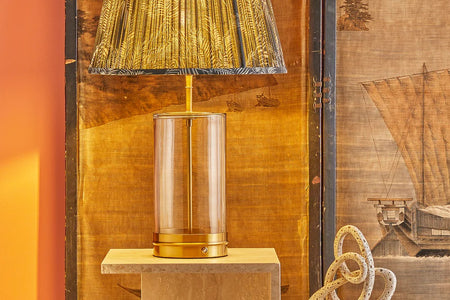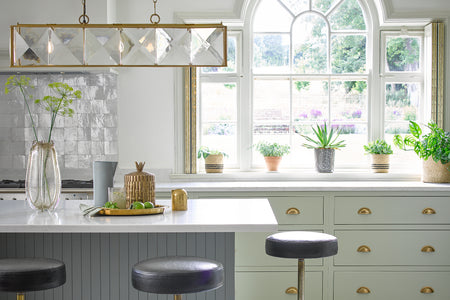From toggles to dimmers to four-gangs – here’s how to choose the best light switch for your lighting needs and for that perfect interior design finishing touch...
So you've found the perfect light fitting – but what kind of light switch do you need? If you don’t know your toggles from your dimmers, or your one gang from your four gang, fear not: our expert guide will enlighten you.
While a shiny new pendant light or chandelier naturally hogs the limelight, it’s also important to choose the right kind of light switch to control it. Light switches come in all sorts of different types and designs, from toggles and dimmers to rockers and sliders, and a range of materials, from classic brass to stylish bronze – so you can find something that suits both your lighting needs and provides just the right finish for your interior decor.
What’s the best type of light switch to use?
The best type of light switch will depend on a number of factors, including how many lights you need to control, and the kind of atmosphere you want to create. The most common types of light switch in a home are toggle switches and dimmer switches, and they’re available in a range of different types and finishes.
How does a light switch work?
A light switch works by controlling the flow of electricity around a lighting circuit. When the switch is closed (turned on), the circuit is completed and the current flows to the light bulb – turning the light on. When the switch is open (turned off), the circuit is broken and the flow is interrupted – turning the light off.
A toggle switch is one of the simplest forms of light switch: your basic on/off switch where you flick the switch up or down. Meanwhile, a dimmer switch has a graduated control which changes the current passing through the circuit to the light bulb, allowing you to vary the brightness of your light fitting.

Florence one gang toggle switch in lovely, buttery brass
When should I use a dimmer switch?
Dimmer switches come in a range of different types, including touch, slide and rotary, with rotary dimmers being the most common type. With a rotary dimmer, you simply turn the dial clockwise or anticlockwise to change the intensity of the light.
The great thing about dimmer switches is they’re so versatile, and can be adjusted to give you exactly the right amount of light. While providing plenty of lighting for practical tasks, such as reading, working or crafting, they also allow you to dial down the light to create the perfect mood and atmosphere – whether you’re entertaining, or just relaxing at the end of a long day.
Dimmer switches are perfect wherever you want to have that extra bit of control over your lighting levels. A dimmer switch is a fabulous addition to a living room or dining room, as it creates a lovely warm, flattering ambient light that’s perfect for a cosy get-together. Meanwhile, a dimmer switch in the bedroom is ideal for providing soft, low-level lighting to help you wind down and get ready for a good night’s sleep (plus it helps to ease the pain a bit when it’s time to get up!)

Florence two gang dimmer switch in stylish bronze
Can you use a dimmer switch with an LED light bulb?
The simple answer is yes. You can use a dimmer switch with a dimmable LED light bulb, and it’s generally possible to replace an existing toggle switch with a dimmer switch, on a like for like basis.
However, it’s important to note that there are two main types of dimmer switch: trailing edge and leading edge. Modern LED light bulbs work best with trailing edge dimmers, and they’re not fully compatible with traditional leading edge dimmers, and as a result they will not function properly.
It’s also important to consider how many LED bulbs your dimmer switch can support. You can work this out by dividing the minimum and maximum load of the dimmer by 10. Then compare this to the combined wattages of your LED bulbs. So, a trailing edge dimmer that’s rated 100-400W would take up to 4 x 10W dimmable LED light bulbs.
(Unless stated otherwise, all of Pooky's light fittings will work within a dimmable circuit, in conjunction with a dimmable LED light bulb. However, we always advise asking a qualified electrician to confirm exactly what can or cannot be used on your lighting circuit.)
What kind of switch do I need to control single or multiple lights?
When choosing a light switch, it’s important to consider exactly what you need it to do. Some light switches are designed to control a single light (or a set of lights on a single circuit), while others are designed to control multiple lighting circuits.
(Here’s the science bit…)
A single – or ‘one gang’ – light switch controls a single light fitting (or a set of lights on the same circuit), for example a single pendant light in a bedroom, or a set of matching wall lights in a living room. The ‘gang’ part refers to the number of switches you can see on the front of the light switch plate.
Light switches can also be used to control multiple locations or circuits, and they have additional terminals on the back. If you want to control a single light (or lighting circuit) from two different places – for example either end of a large reception room, a long hallway, or at the top and bottom of the stairs – you can use a pair of one gang, ‘2-way’ light switches.
(Note - when there are three or more switches on one lighting circuit, such as the bottom of the stairs, halfway up, and at the top, the middle switch will need to be an intermediate switch, also known as a 3-way switch - not currently sold by Pooky).
This Florence four gang dimmer switch in bronze is ideal for a large reception room or an open plan space:
 Four gang florence dimmer switch in bronze
Four gang florence dimmer switch in bronze
At Pooky we make beautiful, affordable lights for beautiful rooms - and now we make beautiful light switches too! View our brand new light switches and sockets.
See also:
Using designer lighting in a bathroom – a safety and style guide











